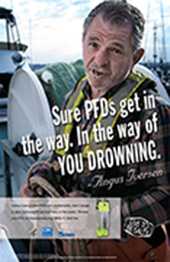COMMERCIAL FISHING SAFETY
Personal Flotation Devices (PFDs)

Falling overboard is the second leading cause of death among commercial fishermen nationwide. Of the 210 fishermen who died from falls overboard between 2000 and 2014 NONE of them were wearing a personal flotation device (PFD) when they drowned. Many of these fatalities would have been prevented if the fisherman had been able to float.
Improving PFD Use among Commercial Fishermen
The NIOSH PFD Study
There is no regulation requiring fishermen to wear a PFD while working. A NIOSH study conducted in 2008 found that 16% of respondents never wear a PFD while working on deck, even though many respondents also said that PFDs are effective at preventing man overboard fatalities. Reasons for not wearing a PFD included perceived lack of comfort, entanglement hazards, and restrictions to movement while working.
In another part of the study, researchers conducted an evaluation with commercial fishermen from four gear groups to rate the comfort and acceptability of six modern PFDs. About 200 fishermen were asked to evaluate a PFD for one month while working on deck so that wearable PFDs could be identified. The results of this study were translated into a series of gear-specific fact sheets that highlight PFDs rated as comfortable by commercial fishermen:
- PFDs that Work: Overview
- PFDs That Work: Crabbers
- PFDs That Work: Dungeness Crabbers
- PFDs That Work: Gillnetters
- PFDs That Work: Longliners
- PFDs That Work: Trawlers
- PFDs That Work: Trawlers
 In 2013, NIOSH and partners created a multi-media health communication intervention to further increase adoption of PFDs among commercial fishermen: Live to be Salty. Live to be Salty was developed in an effort to reduce drownings by promoting the use of PFDs on board commercial fishing vessels. Live to be Salty means to take steps that will lead to a long and productive fishing career.
In 2013, NIOSH and partners created a multi-media health communication intervention to further increase adoption of PFDs among commercial fishermen: Live to be Salty. Live to be Salty was developed in an effort to reduce drownings by promoting the use of PFDs on board commercial fishing vessels. Live to be Salty means to take steps that will lead to a long and productive fishing career.
The intervention centers around messages and quotes from Angus Iversen, an old salt who’s seen it all and lived to tell about it. He gives blunt and often humorous advice to commercial fishermen about why PFDs should be a standard part of working on deck. The project focuses on raising awareness of the risk of man overboard fatalities among commercial fishermen and provides links to locating comfortable personal flotation devices that can be worn on deck while working. Materials for the intervention can be found for printing on the NIOSH Live to be Salty Resource Page and you can interact with Live to be Salty on Facebook and Twitter.
Paul Revere: A Story of Survival in Bristol Bay
Vessel disasters account for over 50% of commercial fishing fatalities in the United States. This video highlights an all too common type of vessel disaster, a rapid capsizing event due to large waves. The story focuses on a vessel that capsizes in Alaska’s Bristol Bay, and the crew was able to survive 2 hours in the cold water due to the inflatable Personal Flotation Devices (PFDs) they wear as standard work gear. The PFDs kept them afloat while they worked on getting to shore. PFDs are a proven solution to extending survival time of workers in the water, even cold water. NIOSH recommends all fishermen find a comfortable PFD and wear it on deck 100% of the time. View this video on the NIOSH YouTube channel.
Man Overboard: Prevention and Recovery
This is a safety awareness video designed to help crew members be more aware of how to prevent and respond to man overboard events. It features interviews with fishermen about experiences with falling overboard, and explains how to successfully recover a person in the water. The video also highlights different equipment that is available such as man overboard alarms and various rescue devices. View this video on the NIOSH YouTube channel.
Also available in DVD format, email nioshfishing@cdc.gov to request a copy.
PFD Study Results
These are the two peer-reviewed journal papers that describe the results of the NIOSH PFD study in 2008/2009
- Predictors of Personal Flotation Device (PFD) use Among Workers in the Alaska Commercial Fishing Industry
Safety Science: March 2013 / 53: 177-185 - Worker Satisfaction with Personal Flotation Devices (PFDs) in the Fishing Industry: Evaluations in Actual Use
Applied Ergonomics: July 2012 / 43(4): 747-752
- Page last reviewed: June 8, 2015
- Page last updated: June 8, 2015
- Content source:
- National Institute for Occupational Safety and Health Office of the Director


 ShareCompartir
ShareCompartir